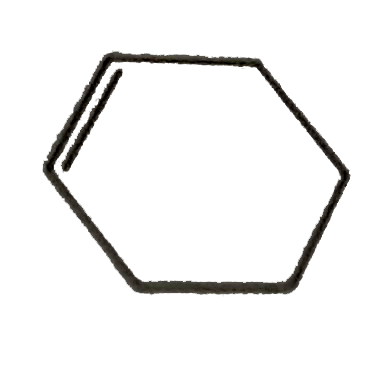If enthalpy of hydrogenation of cyclohexene is [−xkJmol−1] and resonance energy of benzene is [−ykJmol−1] then the enthalpy of hydrogenation of benzene will be
[(y−3x)kJmol−1]
[−(x+y)kJmol−1]
[(y+3x)kJmol−1]
[(x+y)kJmol−1]
The correct Answer is:4
To find the enthalpy of hydrogenation of benzene based on the given information, we can follow these steps:
Step 1: Understand the Given Information
We know:
- The enthalpy of hydrogenation of cyclohexene is −xkJ mol−1.
- The resonance energy of benzene is −ykJ mol−1.
Step 2: Write the Reaction for Hydrogenation of Benzene
The hydrogenation of benzene can be represented as:
C6H6+3H2→C6H12
This reaction shows that benzene (C6H6) reacts with 3 moles of hydrogen (H2) to form cyclohexane (C6H12).
Step 3: Relate the Enthalpy of Hydrogenation
The enthalpy change for the hydrogenation of benzene can be expressed in terms of the enthalpy of hydrogenation of cyclohexene and the resonance energy of benzene:
ΔHhydrogenation of benzene=3×ΔHhydrogenation of cyclohexene−Resonance Energy of Benzene
Step 4: Substitute the Values
Substituting the known values into the equation:
ΔHhydrogenation of benzene=3×(−x)−(−y)
This simplifies to:
ΔHhydrogenation of benzene=−3x+y
or rearranging gives:
ΔHhydrogenation of benzene=y−3x
Step 5: Final Expression
Thus, the enthalpy of hydrogenation of benzene is:
ΔHhydrogenation of benzene=−(3x−y)kJ mol−1
Conclusion
The enthalpy of hydrogenation of benzene can be expressed as:
ΔHhydrogenation of benzene=−y−3xkJ mol−1
We know:
- The enthalpy of hydrogenation of cyclohexene is −xkJ mol−1.
- The resonance energy of benzene is −ykJ mol−1.
The hydrogenation of benzene can be represented as:
C6H6+3H2→C6H12
This reaction shows that benzene (C6H6) reacts with 3 moles of hydrogen (H2) to form cyclohexane (C6H12).
The enthalpy change for the hydrogenation of benzene can be expressed in terms of the enthalpy of hydrogenation of cyclohexene and the resonance energy of benzene:
ΔHhydrogenation of benzene=3×ΔHhydrogenation of cyclohexene−Resonance Energy of Benzene
Substituting the known values into the equation:
ΔHhydrogenation of benzene=3×(−x)−(−y)
This simplifies to:
ΔHhydrogenation of benzene=−3x+y
or rearranging gives:
ΔHhydrogenation of benzene=y−3x
Thus, the enthalpy of hydrogenation of benzene is:
ΔHhydrogenation of benzene=−(3x−y)kJ mol−1
The enthalpy of hydrogenation of benzene can be expressed as:
ΔHhydrogenation of benzene=−y−3xkJ mol−1
Similar Questions
The enthalpy of hydrogenation of cyclohexene is −119.5kJmol−1. If resonance energy of benzene is −150.4kJmol−1, its enthalpy of hydrogenation would be :
View SolutionThe enthalpy of hydrogenation of cyclohexene is −119.5kJmol−1. If resonance energy of benzene is −150.4kJmol−1, its enthalpy of hydrogenation would be :
View SolutionThe enthalpy of hydrogenation of cyclohexene is −119.5kJmol−1. If resonance energy of benzene is −150.4kJmol−1, its enthalpy of hydrogenation would be :
View SolutionResonance energy of benzene is 36kcalmol−1. This means
View SolutionIf enthalpy of hydrogenation of C6H6(l) into C6H12(l) is −205kJ/mol and resonance energy of C6H6(l) is −152kJ/mol then enthalpy of hydrogenation of

Assume ΔHvap of C6H6(l),C6H8(l) all equal :
View SolutionCalculate the enthalpy of combustion of benzene (l) on the basis of the following data:
a. Resonance energy of benzene (l)=−152kJ/mol
b. Enthalpy of hydrogenation of cyclohexene (l)=−119kJ/mol
c. ΔfHΘC6H12(l)=−156kJmol−1
d. ΔfHΘofH2O(l)=−285.8kJmol−1
e. ΔfHΘofCO2(g)=−393.5kJmol−1
View SolutionEnthalpy of hydrogenation of benzene is ΔH1 and for cyclohexene is ΔH2. The resonance energy of benzene is
View SolutionΔfHΘ of Cyclohexene (l) and benzene at 25∘C is −156 and +46kJmol−1, respectively. ΔhydrogenationHΘ of cyclohexene (l)at25∘Cis−119kJmol−1.
Reasonance energy of benzene is found to be −38xkJmol−1. Find the value of x.
View SolutionHeat of hydrogenation of ethene is x1 and that of benzene is x2 . Hence resonance energy of benezene is
View SolutionThe enthalpy of formation of hypothetical MgCl is −125kJmol−1 and for MgCl2 is −642kJmol−1. What is the enthalpy of the disproportionation of MgCl.
View Solution
